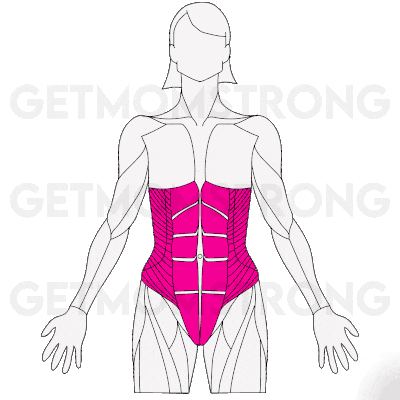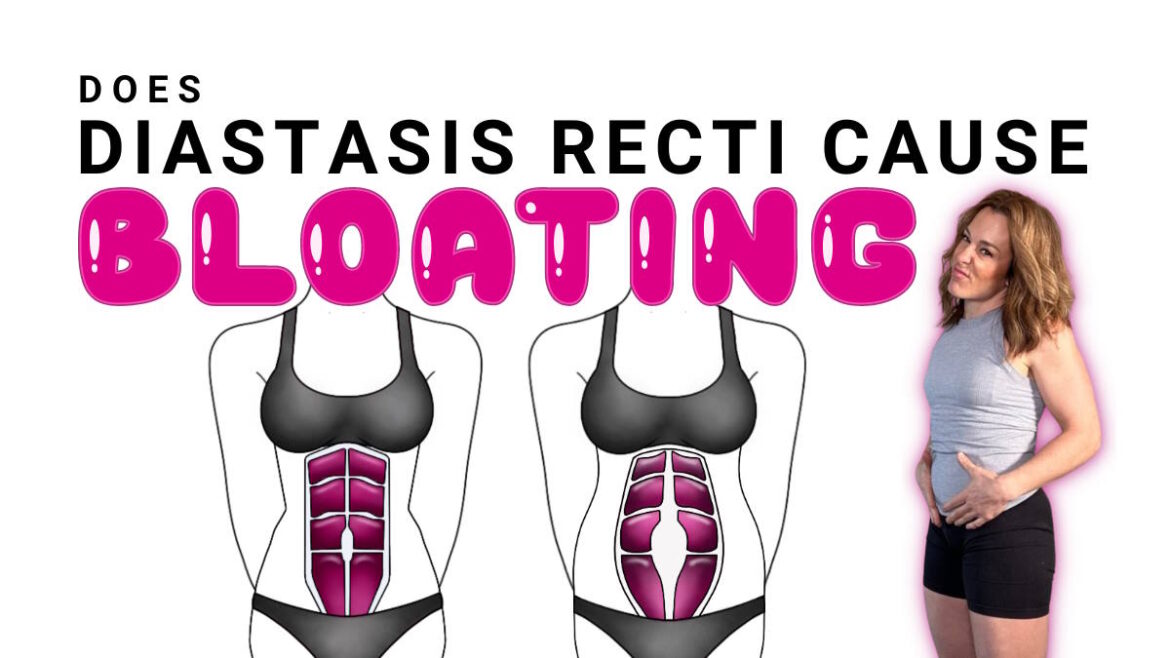This one is for my diastasis recti moms who have ever woken up thinking “my stomach looks so flat today!” but by 5 p.m. notice their belly looks completely bloated. This may leave you wondering… does diastasis recti cause bloating? In short, no, but let’s break this down why you may look more bloated by the end of the day.
Does Diastasis Recti Make Your Stomach Bloat?
A bloated belly does tend to SHOW more after pregnancy, even if you aren’t actually bloating more. Why? Bloating can be a side effect of diastasis recti, which is common among pregnant and postpartum women.
Your transverse abdominals run laterally, like shoelaces, acting as a natural corset for your core. During pregnancy, abdominal muscles stretch to accommodate the growing baby. The connective tissue along your midline, called the linea alba, thins and widens, which leaves a gap between your rectus abdominis, or “six-pack” abs.
This is a risk factor for developing diastasis recti postpartum. After the baby is born, more than half of women still have an abdominal separation.

When your transverse abdominal muscles are weakened due to diastasis recti, and your linea alba is stretched, they can’t support your core very well, and your internal organs put pressure on the abdominal wall. You may notice a tummy pooch or feel bloated more than you did before kids, especially after eating.
In short, you aren’t actually bloating more, but your abdominal muscles aren’t holding your internal organs in as well, so you show any bloat more quickly.
How Do I Reduce Bloating?
Even though bloating has a variety of causes, rebuilding your core, improving posture, proper breathing, and keeping your GI system running smoothly will help reduce bloating.
Also, diastasis recti can exacerbate constipation. Slowed motility means your body has slowed down its digestion process and is likely creating excess gas. Both can lead to more bloating.
Here are my top tips to stay regular, keep things moving, and improve bloating symptoms:
1. Strengthen your Core and Pelvic Floor
Properly and safely working to heal your diastasis recti and pelvic floor will have a major impact on bloating. It takes time, but most people can strengthen their core muscles and improve symptoms – even years later, and without diastasis recti surgery (aka a tummy tuck)!
2. Breathe Properly
Breathwork helps heal your core, repair a persistent belly pooch, and manage bloat. Diaphragmic, or deep belly breathing, gently massages your internal organs. Activating your diaphragm also helps put your body back into the “rest and digest” state and can reduce abdominal pain, urgency, bloating, and constipation.
You can find a lot more information on proper breathing in my Core Basics program (included with your Strong Like A Mother subscription).
3. Stand Up Straight
Mom life is demanding. You spend hours hunching over a nursing baby, picking up your kid (and all their stuff), or one of a million other things. Your abdominal muscles stabilize your spine, and a compromised core can lead to poor posture. Poor posture can make diastasis recti worse – it’s a vicious cycle.
Remind yourself to focus on alignment (shoulders back, hips square, pelvis neutral). This allows you to best find the support of the core and pelvic floor…not only in the gym, but as you move about your day. Read my post with tips for improving posture.
4. Drink More Water
Your body needs a lot of water, and most of us are mildly dehydrated. It may feel counterintuitive, but drinking water encourages your body to keep what it needs and let go of what it doesn’t. (Bye, bye bloat.)
When your body is properly hydrated, your stool will be softer and easier to pass. Help flush the bloat with some of nature’s diuretics, such as asparagus, pineapple, peaches, cucumber, watermelon, leeks, ginger, and garlic.
Tip: Add fresh lemon juice to water for a flavor boost – the citrus can also help stimulate bowels.
5. Eat That Fiber
Fiber is notorious for helping things “move along”, but as busy moms we’re on the go and most of us don’t consume enough of it. Fiber adds bulk and softens stool, making it easier to eliminate, resulting in less belly bloat. Some of my favorite fiber sources include fruits, veggies, chia seeds, and whole grains.
Tip: Add the ingredients to my Poop Balls recipe to your grocery list. When I need to get things moving, these tasty balls are perfect.
6. Use a Poop Stool
A Squatty Potty or similar stool puts your body into the optimal position when it’s time to go #2. If you experience incomplete voiding (i.e. you don’t feel like you’ve gotten everything out), a simple shift in body mechanics can make a big difference.
When to Seek Help
Even though bloating can be a side effect of diastasis recti, there may be other factors at play, such as food intolerance(s) and other gastrointestinal issues. Please speak with a medical professional if you need help managing symptoms.
And remember, all bodies bloat. Men and women were designed with some elasticity in their midline to accommodate eating, weight gain/loss and just living daily life. But excessive bloating and constipation can also be symptoms of diastasis recti. Strengthening your core, staying regular and improving posture and breathing will provide relief.
